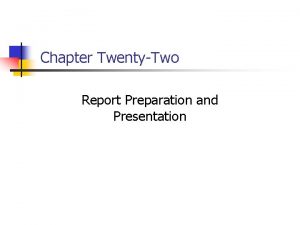Sample Preparation and Sample Presentation for Direct Analysis

- Slides: 1

Sample Preparation and Sample Presentation for Direct Analysis in Real Time (DART) Robert B. 1 JEOL *1, Cody A. John 1 Dane , USA Inc. , Peabody MA; Drew 2 Nanoliter “Less is More” 2 Sauter and A. D. Sauter 2 III LLC, Henderson, NV A DART Glow Discharge Stimulant Drug Mixture 100 ppb oxazepam in 200 ppm creatinine Introduction: The DART [1, 2] ionization mechanism is dominated by gas-phase ionmolecule reactions [3]. Like atmospheric-pressure chemical ionization (APCI), matrix effects in positive-ion mode are related to the relative proton affinities of compounds present in a mixture. Condensed-phase phenomena that cause suppression in electrospray ionization (e. g. competition for the surface of a drying droplet) do not play a role in DART ionization. Nevertheless, suppression can occur with the DART ion source if a trace analyte with a relatively low proton affinity is associated with a large excess of a compound with a relatively high proton affinity. Stout and coworkers have shown the suppression of oxazepam in the presence of a large excess of creatinine [4]. Liquid samples have commonly been analyzed by DART ionization by dipping the sealed end of a glass rod, such as a 2 mm-diameter melting point tube, into a liquid sample. Alternatively, several microliters of sample are deposited onto the outside of the glass rod which is then positioned within a few millimeters of the DART ion source exit grid. Here we show that by presenting nanoliter droplets directly in front of the DART ion source, suppression effects are drastically reduced, resulting in better detection limits and a more uniform response for mixture components. The ultimate goal is to achieve efficient ionization and transmission into the API interface of the entire sample. Figure 1. Stronger signals are observed for low-m/z compounds in stimulants mixture when 50 nanoliter droplets are used (bottom) compared to 2 ml droplets (top). The compounds in the mixture are: 1 = amphetamine, 2 = methamphetamine, 3= caffeine, 4= methylphenidate, 5= cocaine. Experimental: An atmospheric pressure ionization time-of-flight mass spectrometer (JEOL Accu. TOF™) equipped with a DART ion source (DART-SVP ™ from Ion. Sense™) was used for all measurements. The DART ion source was operated with helium gas at a flow rate of approximately 1. 2 liters per minute. The DART gas heater was set to 350°C and the DART exit grid was set to +250 V. The mass spectrometer atmospheric pressure interface was operated with the following potentials: orifice 1 = 20 V, orifice 2 and ring lens = 5 V. The RF ion guide voltage was set to 1000 V to transmit and detect ions of m/z 100 and greater. Aqueous solutions containing 200 mg/ml (= 200 ng/ml) of creatinine were spiked with oxazepam at levels of 100 pg/ml, 1 ng/ml, 100 ng/ml, and 100 ng/ml. DEA-exempt solutions (Alltech) of a 1 mg/ml methanol solution of 5 stimulant drugs were analyzed without further dilution. Approximately 50 nanoliter droplets of each solution were manually deposited within 1 -2 mm in front of the exit grid of the DART ion source by using Nanoliter LLC's patent-pending nano. Liter Cool Wave pipette. For comparison, 2 ml aliquots of the solutions were pipetted onto the outside of the sealed end of 2 mm Pyrex melting point tubes which was then positioned within 2 mm of the DART exit grid for analysis by using the DART -SVP linear rail. All measurements were made in triplicate to average out variations in signal intensity due to variations in sample placement. Results: We observed that signal suppression for low-m/z components in the stimulant mixture was clearly reduced for 50 nl sample introduction compared to 2 ml volumes (Figure 1). This led us to wonder if this was a general phenomenon that could be reproduced for the documented example of oxazepam in the presence of excess creatinine. The results from 50 nl droplets were compared to the results for 2 ml deposited on melting point tubes. Suppression of oxazepam by creatinine was significantly reduced by using nanoliter droplets, resulting in better detection limits. Oxazepam could barely be detected in an actual urine sample at the 1 ng/ml level (not shown) but the ability to detect oxazepam in the presence of other chemical interferences from urine was limited by the mass spectrometer resolving power. Improving signal by reducing sample quantity is a well-known phenomenon in mass spectrometry and had been shown for FAB, ESI and other ionization methods. A significant improvement in MALDI sensitivity was observed for nanoliter sample deposition [5] MH+water ________ = 8 MH+200 ppm creatinine MH+water ________ = 87 MH+200 ppm creatinine Figure 2. RICs for 1 ng/ml solution of oxazepam in DI water (left) and in 200 ng/ml aqueous creatinine (right). Suppression of the oxazepam signal is significantly reduced when 50 nl droplets are analyzed (top) compared to 2 ml droplets (bottom). The analyte signal in 200 ppm creatinine is approximately 4 x greater for the 50 nl droplets, despite the fact that the sample quantity is 80 x less than for the 2 ml droplets. The analyte signal in water is only reduced by a factor of 2 in going from 2 ml to 50 nl samples. Note that the time scales are not identical. Nanoliter droplets can be introduced with the nanoliter pipette and analyzed more rapidly than microliter droplets could be deposited on a melting point tube and introduced with the linear rail. MH+ m/z 287. 057 Figure 4. 100 pg/ml oxazepam. Top: 2 ml droplet (200 ng/ml creatinine) on melting point tube. Middle: 50 nl droplet (200 ng/ml creatinine). Bottom: 50 nl droplet (DI H 2 O). Little or no suppression was observed for this concentration. Conclusions: • Sample introduction as nanoliter droplets results in a significant reduction in sample suppression. • Nanoliter droplets permit better detection limits than the commonly-used melting-point tube method, despite the smaller sample volumes used. Detection limits reported here are 10 to 100 times lower than previously reported values for the same solution concentrations. • The working hypothesis is that an excess of reagent ions in the DART gas stream results in complete ionization of the all of the components in the nanoliter droplets. In contrast, if larger samples volumes are used, the number of analyte molecules can exceed the number of reagent ions and charge competition can occur. • Shorter desorption times for the nanoliter droplets result in temporal focusing of the signal, perhaps reducing discrimination of volatile components and improving the signal-to-background. References Figure 3. 1 ng/ml oxazepam in urine measured as a 50 nl droplet. The detection limits are determined by the ability to separate analyte from background, not by suppression. 1. DART is a trademark of JEOL USA, Inc. . 2. US Patent Number 6, 949, 741. Other patents pending. 3. Cody, R. B. ; Laramée, J. A. ; Durst, H. D. Versatile New Ion Source for the Analysis of Materials in Open Air under Ambient Conditions. Anal. Chem. , 2005, 77(8), 2297 - 2302 DOI: 10. 1021/ac 050162 j 4. Stout, P. R. ; Bynum, N. ; Minden, E. ; Miller, J. “Evaluation of Accu. TOF DART for Postmortem Toxicology Screening” NIJ Technology Transition Workshop. <http: //projects. nfstc. org/tech_transition/dart 08/presentations/Stout. ppt> 5. Tu, T. , Sauter, A. D. , Gross, M. L. , Improving the Signal Intensity and Sensitivity of MALDI Mass Spectrometry by Using Nanoliter Spots Deposited by Induction-Based Fluidics, Journal of the American Society for Mass Spectrometry (2008), doi: 10. 1016/j. jasms. 2008. 03. 017.

